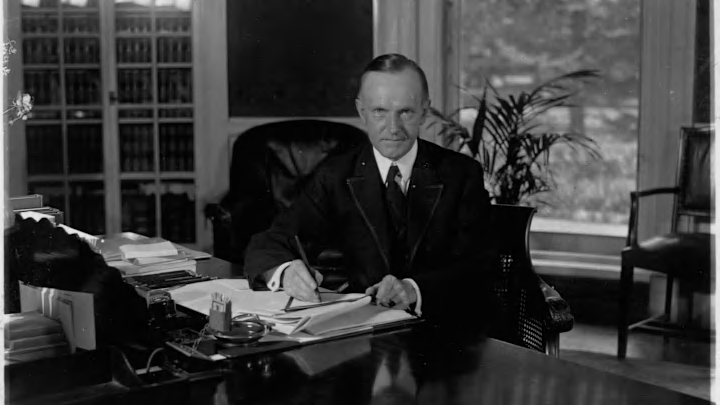The 30th president of the United States, Calvin Coolidge (1872-1933), left office just as America was about to shift from an era of great joviality, the Roaring Twenties, to one of unprecedented economic despair, the Great Depression. A stern figure, Coolidge was all business, practicing minimalism in both his social activity and in his political career. Here's what you should know about one of our nation’s more intriguing commanders-in-chief.
1. Calvin Coolidge is the only president born on the Fourth of July.
John Calvin Coolidge was born in Plymouth Notch, Vermont, on July 4, 1872—giving him the distinction of being the only president born on the Fourth of July. (Three of the first five U.S. presidents died on the Fourth of July, however: Thomas Jefferson and John Adams in 1826, and James Monroe in 1831.)
2. Coolidge was elected to political office the same year he opened his own law firm.
Coolidge was an engaged student. He graduated with honors from Amherst College in 1895, then earned his law degree. After passing the bar, he opened a firm in Northampton, Massachusetts, in 1898, and was elected to the town's city council. That modest office sparked an escalating interest in politics that led to his election as governor of the state in 1918.
3. A police strike made Coolidge a household name.
In 1919, Coolidge faced his biggest challenge yet as a politician when a police strike led to panic and violence in the streets of Boston. After sending in the state guard to quell the tension, Coolidge admonished the officers for leaving their posts. That hard-line stance impressed the public at large, and by 1920, he was an easy pick for a vice-presidential nomination on the Republican ticket next to presidential nominee Warren G. Harding. When Harding died just two years into his term, Coolidge found himself in the Oval Office.
4. Coolidge's own father swore him in.
In a moment that had never transpired before and has never been repeated, Coolidge was sworn into the presidential office by his own father, also named John Calvin Coolidge. The pair found themselves together while the younger Coolidge was visiting his father in Vermont. News arrived of Harding’s sudden death, which prompted Coolidge Senior, a notary public, to swear in his son in the middle of the night.
5. Coolidge was popular for doing nothing.
In contrast to presidents who had a heavy hand in American affairs, Coolidge captured the public’s favor by essentially doing nothing. He allowed businesses to prosper by minimizing government interference and satisfied voters who believed bureaucracy had become too overwhelming. But his conservative approach may have been a little too reserved. He's quoted as saying that he spent much of his presidency “avoiding the big problems.” Critics later argued his reluctance to stem the stock market speculation boom in the 1920s may have contributed to the market crash in 1929.
6. Coolidge wasn't very talkative.
Complementing his understated political style was Coolidge’s economy of words. Though he was communicative with the public, holding about eight press conferences a month and making regular radio addresses, direct dialogues were more succinct. He often answered “yes” or “no” to questions posed by the press or associates and prided himself on remaining largely quiet in social settings. According to legend, a dinner companion offered to bet she could extract at least three words from him during the evening. Coolidge turned to her and said, “You lose.”
7. His wife, Grace Coolidge, brought attention to the hearing-impaired.
Grace Goodhue Coolidge, whom Coolidge had married in 1905, was a onetime instructor for Deaf people, a population who had not received much in the way of national attention. Grace was interested in raising awareness; she educated the public and invited Helen Keller to the White House. Grace was able to raise $2 million for the Clarke School for the Deaf in Northampton, assisted by her husband, who often told friends to contribute to the school.
8. Coolidge rode a mechanical horse for exercise.
After his horseback riding activities were reportedly curtailed by concerned Secret Service agents, Coolidge installed a mechanical horse saddle in the White House. The machine ran on electricity and was able to mimic the bouncy agitation of trotting or galloping, and Coolidge rode the contraption up to three times a day, believing it was beneficial to his health. Referred to as “Thunderbolt,” by the press, the device was widely mocked by observers who felt riding a replica horse was not conduct befitting a president. Coolidge eventually tired of it, opting for other ill-advised exercise contraptions like a belly-reducing vibrating machine.
9. Coolidge was the first sitting president to visit Cuba.
Coolidge was the first—and, until Barack Obama went there in 2016, the only—president to to travel to Cuba while still in office.
When he arrived in Havana for a conference, Coolidge seemed pleased at the warm reception expressed by citizens there—so much so that he temporarily broke free of his laconic stature and took a bow. Maybe it was the grandiose entrance: Coolidge pulled up to Havana in the U.S.S. Texas, a World War I battleship.
10. Coolidge pardoned a raccoon.
Coolidge was very fond of animals, collecting everything from cats to birds to lion cubs that he wryly named Tax Reduction and Budget Bureau. For Thanksgiving in 1926, an admirer sent him a live raccoon with the suggestion he cook it and consume it as part of the family dinner. Wary of sampling raccoon meat, Coolidge “pardoned” the animal and it soon became a close friend of his wife's and was given the name Rebecca Raccoon. But the pet’s undomesticated status became a source of contention among the Secret Service: She was prone to ripping up furniture and speeding through the White House. Rebecca was eventually donated to a zoo in 1928, Coolidge's final full year in office.
A version of this story ran in 2019; it has been updated for 2022.
